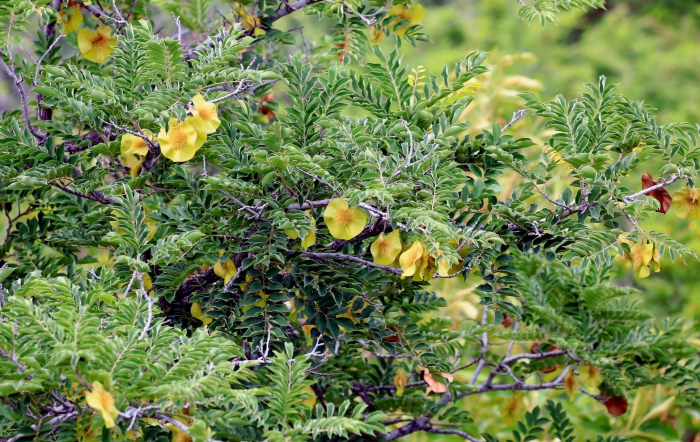African Teak
(Pterocarpus angolensis)
African Teak (Pterocarpus angolensis)
/
/

Wynand Uys
CC BY 4.0
Image By:
Wynand Uys
Recorded By:
Copyright:
CC BY 4.0
Copyright Notice:
Photo by: Wynand Uys | License Type: CC BY 4.0 | License URL: http://creativecommons.org/licenses/by/4.0/ | Rights Holder: Wynand Uys | Publisher: iNaturalist | Date Created: 2024-01-14T08:08:18-08:00 |

























Estimated Native Range
Summary
Pterocarpus angolensis, commonly known as African Teak or Kiaat, is a deciduous tree native to the woodlands and savannas of southern Africa, including Angola, Mozambique, Namibia, and South Africa. It can grow up to 52 feet (16 meters) tall with a typically rounded crown. The bark is dark brown and rough, providing a striking contrast to the compound leaves that are made up of small, rounded leaflets. This species is known for its scented, orange-yellow flowers that bloom in clusters, primarily during the spring season. The flowers are modest in size but can be quite showy when the tree is covered in them. Following the flowering period, the tree produces distinctive spiky seed pods.
African Teak is highly valued for its durable, termite- and borer-resistant wood, which is used in high-quality furniture, canoes, and musical instruments. The tree’s red sap, which is where it gets the nickname "Bloodwood," is traditionally believed to have magical healing properties. In cultivation, it is used for its ornamental qualities and shade provision. It prefers full sun to partial shade and thrives in well-drained soils. While it is a valuable timber species, it is also planted for its aesthetic appeal and is sometimes used in reforestation projects. However, it is slow-growing and requires patience to reach maturity.CC BY-SA 4.0
African Teak is highly valued for its durable, termite- and borer-resistant wood, which is used in high-quality furniture, canoes, and musical instruments. The tree’s red sap, which is where it gets the nickname "Bloodwood," is traditionally believed to have magical healing properties. In cultivation, it is used for its ornamental qualities and shade provision. It prefers full sun to partial shade and thrives in well-drained soils. While it is a valuable timber species, it is also planted for its aesthetic appeal and is sometimes used in reforestation projects. However, it is slow-growing and requires patience to reach maturity.CC BY-SA 4.0
Plant Description
- Plant Type: Tree
- Height: 30-50 feet
- Width: 20-30 feet
- Growth Rate: Slow
- Flower Color: Yellow
- Flowering Season: Spring
- Leaf Retention: Deciduous
Growth Requirements
- Sun: Full Sun
- Water: Medium
- Drainage: Medium, Fast
Common Uses
Bee Garden, Erosion Control, Low Maintenance
Natural Habitat
Woodlands and savannas of southern Africa
Other Names
Common Names: African Teak, Mukwa, Ambila, Bleedwoodtree, Bloodwood, Kiaat, Mokula, Mukula
Scientific Names: , Pterocarpus angolensis, Pterocarpus bussei, Pterocarpus dekindtianus, Pterocarpus dekindtianus var. latifoliolatus, Pterocarpus dekindtianus var. latifoliolatus,
GBIF Accepted Name: